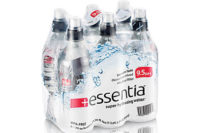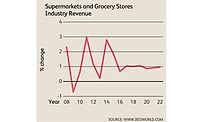By offering a wide variety of items such as food, beverages, health products and more, supermarkets have managed to remain relatively stable in terms of store performance during the last year, experts suggest. Coming off of a period of stagnant growth from 2008 to 2011, supermarkets now seem to be on the upswing with 2.5 percent growth in retail sales in 2012, says Jonas Feliciano, beverage analyst at Chicago-based Euromonitor International. In fact, supermarkets are outperforming other retail channels in terms of grocery sales, says Susan Viamari, editor of Times & Trends for Chicago-based SymphonyIRI Group.
“For example, across all [consumer packaged goods] (CPG) outlets, [shopper] frequency slipped 1 percent last year, and frequency within the grocery channel slipped a half of a percent, so it’s better than the industry average,” Viamari says. “Likewise, the industry average basket [sales] grew a half of a percent; in groceries, basket [sales] grew 2.6 percent.” Some of this growth is due to price increases, she notes.
Another major factor in shopper frequency and basket sales has been a trend toward shoppers making less frequent but larger pantry stocking missions, according to SymphonyIRI’s August 2012 report, “Channel Migration: Charting a Course on the Voyage for Value.”
“During the past year, pantry stocking missions declined 1.7 percent [in frequency], with particularly sharp declines evidenced in the first quarter of 2012,” the report states. “Per trip spending increased slightly versus prior year during the past several quarters, and a full year-over-year comparison showed average basket size inched up 0.4 percent for the year.” Pantry stocking missions are recovering from consumer trends during the recession to make quick fill-in trips and buy items only when they are needed, rather than stock their pantries, it says.
On average, consumers spend $85.26 during each supermarket trip, Chicago-based Mintel reported in its July 2012 report, “Shopping for Groceries.”
Santa Monica, Calif.-based IBISWorld states in its September 2012 report, “Supermarkets and Grocery Stores in the U.S.,” that the industry accrued more than $491 billion in revenue in the first three quarters of 2012. Beverage accounts for 7 percent of these sales, the market research firm reports.
According to SymphonyIRI data, the supermarket and grocery store channel saw increases in sales across many beverage categories, including a 22.1 percent increase in pre-mixed cocktails for more than $245 million and a 2 percent increase in non-alcohol cocktail mixes for more than $152 million in the 52 weeks ending Nov. 4.
“I know in the past year, for example, Skinnygirl [pre-mixed cocktails] gained solid distribution in the grocery channel, so that’s really helping to bolster share in those areas,” SymphonyIRI’s Viamari says.
The channel also experienced growth in shelf-stable, canned and aseptic juices and juice concentrates as well as coffees and teas, according to SymphonyIRI data. Euromonitor’s Feliciano says this increase is because of how shoppers tend to consume these products. Because juices, coffees and teas are popular beverage choices for breakfast, shoppers tend to include them on their lists for their grocery missions, he says.
On the other hand, Feliciano adds that grocery stores and supermarkets are losing share for single-serve, ready-to-drink beverages to convenience stores because these products tend to be impulse purchases used for on-the-go consumption. However, SymphonyIRI reports that sales for ready-to-drink coffee and tea grew 2.5 percent in grocery store and supermarket channels during the 52 weeks ending Nov. 4, 2012.
Trying to stay on top
Although the grocery and supermarket channels control the majority (nearly 48 percent) of CPG dollar share, according to SymphonyIRI’s August 2012 Channel Migrations report, other retail channels including supercenters, mass merchandisers and dollar stores also are vying for a greater share.
According to the report, supercenters account for 18.6 percent of CPG dollar share; mass merchandisers make up 5.7 percent; and dollar stores account for 1.9 percent.
“Everyone’s competing more for share of food and beverage,” SymphonyIRI’s Viamari explains. “There’s just more competition.”
By extension, Barrington, Ill.-based Willard Bishop predicted in its June 2012 report, “The Future of Food Retailing,” that the market share for traditional grocery will decrease 1.4 percentage points while non-traditional grocery channels will increase share to 39 percent and convenience stores will increase to 15.6 percent by 2016.
As mass merchandisers and supercenters expand their grocery offerings, they also offer consumers a one-stop shopping experience for their grocery and other retail needs sometimes at lower prices because of their bulk format. Similarly, CPG products available at dollar stores compete with those available in grocery stores due to their lower price point.
“Supermarkets still do have probably the best array of different products, but through the recession and as a result of the recession, consumers have been less concerned with what the brand is; they’re more concerned with the prices, and that’s leading them to go elsewhere,” says Eben Jose, industry analyst at Santa Monica, Calif.-based IBISWorld.
To compete with this trend, supermarkets and grocery stores can highlight the different shopping experiences they offer compared with other retail environments, such as uninterrupted grocery shopping. “When I’m in grocery mode, it’s all right here, and there’s not a whole bunch of extraneous stuff; … the warehouses/clubs have all of the appliances and books and all of that kind of thing,” SymphonyIRI’s Viamari says. “In my perspective, the grocery store has more of a balance of what one looks for when one’s doing a typical pantry-stocking or even fill-in grocery trip. And I think that these days, [grocery stores] are doing an even better job of positioning themselves with respect to the value that they’re offering for those goods than they had done in the past.”
Another tactic to promote grocery store and supermarket growth is to position the retail segment as suitable for a different type of shopping occasion, Feliciano suggests. If consumers are moving their big shopping trips to mass merchandisers and supercenters, perhaps the quick fill-in trips can move up to the supermarkets and grocery stores, he says.
“The shopping experience at some of these other large-format [mass merchandise and supercenter] stores can be a little bit harrowing and require a large time investment,” Feliciano explains. “But if I’m just grabbing some food for the night … that’s where these smaller grocery formats can compete with things such as convenience stores or independent small grocers or things such as that.”
In its report, “Shopping for Groceries,” Mintel reported that 84 percent of surveyed regular supermarket shoppers find it fast and easy to shop and check out of their local supermarkets. “As shoppers remain loyal to a particular retailer and frequently visit the same store, it is easy for them to find the products on their lists quickly and easily since they know how to navigate through the store,” the report states. The report also notes that store planners should take this into consideration when planning store layout changes so as not to hinder the consumer shopping experience.
Smaller trips can be the new space for supermarkets and grocery stores to play in, Feliciano says. Although they still want consumers to come to the store for their big shopping trips for groceries that will last a week or more, they might have trouble competing with mass merchandisers and supercenters, he says. However, the convenience concept offers the grocery store and supermarket channel an opportunity to regain some share there, he adds.
Supermarkets also can compete on price points by offering private label products, IBISWorld’s Jose suggests. In creating products similar to name brand products, supermarkets can offer consumers an inexpensive option that can allow them to compete a little bit better with the prices of dollar stores, he says.
Using private labels also is a good way for a chain to hone its value proposition for the consumer by highlighting the quality, affordable products on its shelves, SymphonyIRI’s Viamari says. Some supermarket private label lines, like Kroger’s Simple Truth and Safeway’s Safeway Kitchens, have become very well respected, gained a loyal following and are being used to elevate their parent chain’s value proposition, she says. IBISWorld estimates that private label accounted for 11 percent of total supermarket sales in 2012.
To keep consumers coming back, supermarkets and grocery stores also can implement shopper loyalty programs to allow consumers to accrue points toward future purchases or offer them a discount at the register for being a loyal shopper. A recent successful example of this is the My Jewel-Osco Fuel Rewards program, which launched last June in the Chicago market, Euromonitor’s Feliciano says. Through a partnership with Shell gas stations, participating Jewel-Osco stores offer consumers savings of 5 cents per gallon on a single fill-up of 20 gallons or less at participating Shell stations for every $50 spent in qualified purchases at participating Jewel-Osco stores, the company says.
“That’s sort of an acknowledgment that both in terms of grocery shopping and in terms of gas prices, those are two areas where [consumers] are very price conscious,” Euromonitor’s Feliciano says. “I think that was a smart move on their end to try to drive more people back to Jewel.”
Supermarkets and grocery stores also can boost share by bringing value and CPGs to areas where these needs are not being met, IBISWorld’s Jose adds. A lot of supermarkets are trying to combat competition by determining what location is best and possibly underserved at the time of opening, he explains. BI







